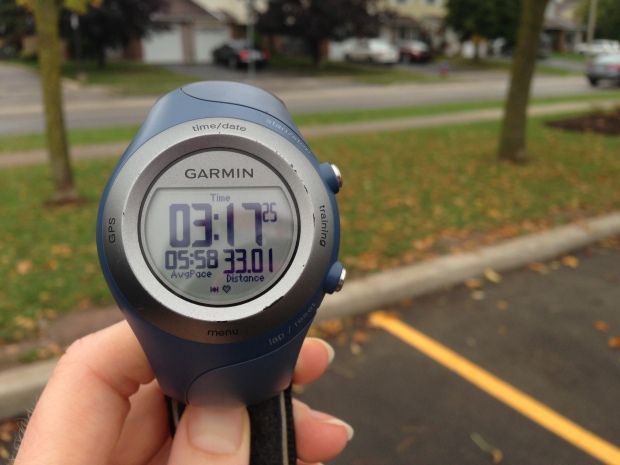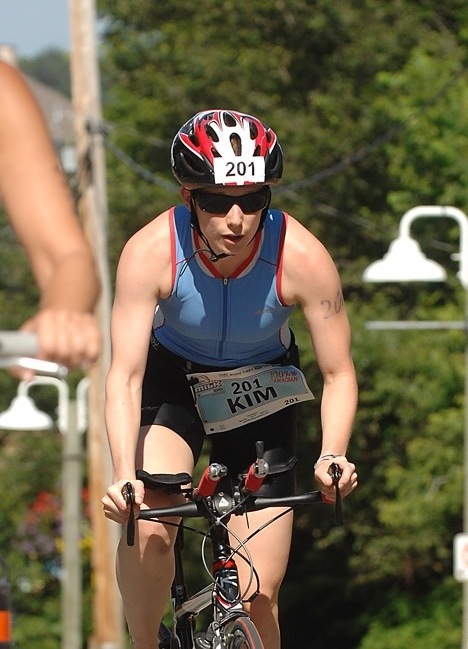This past summer I drastically increased my training load over what I had done in the past, from “you run a lot” to “wow, are you ever NOT training??”, and also quickly realized that increased mileage and training frequency (and therefore decreased recovery time) means more aches and pains that can easily turn into injuries. This fall’s marathon training and the subsequent focus on running has forced me to learn the weaknesses of my body, what I can run through and what I can’t, and how to manage the aches and pains before they become injuries that stop me from running altogether.
Although I’m hardly an expert on recovery and injury prevention, there are a few things that have had a huge impact on keeping me on my feet and training – things I really wish I knew about when I started logging those extra miles. Let me know if I missed any of your favourites! :)
BodyGlide
 Pretty much every endurance athlete I know uses BodyGlide on at least something during race day, but I betcha I put it in a weirder spot than most… Get your mind out of the gutter, everyone puts it there! :)
Pretty much every endurance athlete I know uses BodyGlide on at least something during race day, but I betcha I put it in a weirder spot than most… Get your mind out of the gutter, everyone puts it there! :)
Whenever I run more than about 18km, I have to rub BodyGlide between my toes or I’ll get blisters. Actually, between my toes is about the only spot I get blisters, and it’s really annoying because changing shoes or socks makes no difference (and before you suggest it, I’m not running in toe socks or FiveFingers). BodyGlide between the toes is less gross than it sounds, and an absolute lifesaver when training or racing long.
Foam Roller
 What would I ever do without my trusty blue foam roller? Like everyone else, I bought mine and then ignored it for a couple months until my Achilles started bothering me during runs. A few days (and complete disappearance of my pain) was all it took, and now I spend about 10 minutes or so with my roller most nights. Sometimes it’s just a quick roll on whatever’s tight, but I’ve actually spent over 40 minutes of quality time with my roller before when I had time, and was it ever
What would I ever do without my trusty blue foam roller? Like everyone else, I bought mine and then ignored it for a couple months until my Achilles started bothering me during runs. A few days (and complete disappearance of my pain) was all it took, and now I spend about 10 minutes or so with my roller most nights. Sometimes it’s just a quick roll on whatever’s tight, but I’ve actually spent over 40 minutes of quality time with my roller before when I had time, and was it ever painful wonderful.
I started by looking up some videos on Youtube (this is my favourite), and then modified the techniques as I progressed. At first I would have screamed in pain if I tried to put my full body weight on the roll, but now I can (most days) roll most major muscle groups without having to support myself too much.
Stretching

So we all know that lots of training means some things get looser – like my pants (yay) – while other things get tighter – like my abs (yay) and …EVERY MAJOR MUSCLE BELOW MY WAIST. This usually means I end up getting weird looks for stretching my IT band in the office kitchen while waiting for the kettle to boil, or sticking my butt out so I can get a good hamstring stretch when I bend down to pick something up! Kind of embarrassing…
Anyway, about the time I started making rolling a routine I also started doing a few little stretches afterwards. Sometimes I do some sun salutations or warrior poses when I get up, but most of the time I get down on the floor before bed, roll out, then spend a few minutes relaxing from the day and stretching out whatever feels tight. I never thought I would say this, but it’s actually one of my favourite parts of the day now.
Massage Therapy

Finding a great massage therapist is like finding treasure! A friend of mine recently recommended I visit Sharon, and I was blown away by how well her technique aligns with what I like – and what I like is PAIN! Really getting into a deep tissue massage can be incredibly painful, but once the bruises heal (yes I actually bruise, and yes I’m actually proud of it), everything feels so much better and I’m able to keep a higher training load without getting injured. I usually go every couple of months because I’m not made of money, and use my foam roller for maintenance in between torture sessions.
I always joke that RMTs would make the best interrogators, because they know just how to find that spot of exquisite pain and keep working it until you cry for mercy. It’s pretty much true, except we pay them for the pleasure. Can anyone deny that we’re crazy?
Epsom Salts Baths

After a massage, a race or a hard workout (or sometimes just because it’s cold out and I had a rough day), there isn’t much that beats an Epsom salts bath. It’s a very simple but incredibly relaxing treat, especially when paired with candles, wine, and a book of your choice. Also helps with DOMS, aka the reason you can’t walk properly after a race.
A few times a year I go all out with the relaxation and recovery, and make the trip down to Body Blitz Spa (pictured in the photo) where I can spend a few hours in the sauna, steamroom, dead sea salt and Epsom salts pools, and the cold plunge pool that is both freezing cold and totally worth it. Ahhhh….
Sports Physician

If all else fails as it inevitably will at some point, a good sports physician can mean the difference between arguing over a diagnosis and treatment plan with your family doctor (spoiler: it’s always 6 weeks rest and to stop training so much), and having someone whose goal is to get you back up and training for that Ironman as soon as possible. I see Dr. Douglas Stoddard at Sports & Exercise Medicine Institute (SEMI) in Toronto, and not only is he highly recommended within the athletic community, but consultations with him are also covered by OHIP (Also: SEMI has a referral program, which means you get a massage for every three people you refer. So tell him I sent you). If you’re looking for a doctor and don’t live near Toronto, try checking the physician directory at the Canadian Academy of Sport and Exercise Medicine.
Specific Nutritional Supplements

The best way to get the proper nutrients is from real food through a healthy, balanced diet, but I’ve also found that supplementing with specific vitamins (B12 and D) has a significant impact on my energy level, sleep quality and mood. Good quality sleep, and therefore the energy to make it through my workouts, has helped me train better and recover faster, and means I’m not snapping at everyone I see for the rest of the day! I also take an iron supplement since I am prone to anemia, particularly when I’m running a lot.
Learn from my mistakes: I discovered through trial and error – mostly error – that vitamins B12 and D are energizing and therefore have to be taken in the morning, unless you want to be up all night, so keep that in mind if you decide to take these vitamins. I’ve got a pretty good system going for me now, and if I notice I’m feeling unusually tired it’s because I’ve missed a few days.
That pretty much covers my recovery and injury prevention inventory. If you’ve got more suggestions, please leave me a comment so I can try out some of your favourites!
Happy training!




 Pretty much every endurance athlete I know uses BodyGlide on at least something during race day, but I betcha I put it in a weirder spot than most… Get your mind out of the gutter, everyone puts it there! :)
Pretty much every endurance athlete I know uses BodyGlide on at least something during race day, but I betcha I put it in a weirder spot than most… Get your mind out of the gutter, everyone puts it there! :) What would I ever do without my trusty blue foam roller? Like everyone else, I bought mine and then ignored it for a couple months until my Achilles started bothering me during runs. A few days (and complete disappearance of my pain) was all it took, and now I spend about 10 minutes or so with my roller most nights. Sometimes it’s just a quick roll on whatever’s tight, but I’ve actually spent over 40 minutes of quality time with my roller before when I had time, and was it ever
What would I ever do without my trusty blue foam roller? Like everyone else, I bought mine and then ignored it for a couple months until my Achilles started bothering me during runs. A few days (and complete disappearance of my pain) was all it took, and now I spend about 10 minutes or so with my roller most nights. Sometimes it’s just a quick roll on whatever’s tight, but I’ve actually spent over 40 minutes of quality time with my roller before when I had time, and was it ever 












